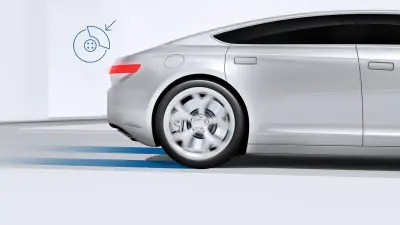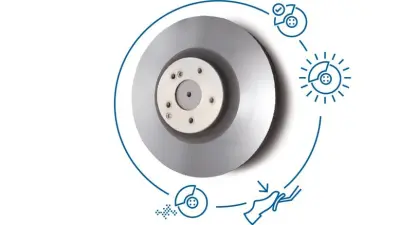iDisc – a key contribution toward improving our air quality

Bosch is closing the gap between standard cast iron and premium ceramic brake disc rotors, offering much more than these two familiar concepts. iDisc brake disc rotors feature a non-corrosive tungsten carbide coating. Apart from a visually-attractive, high-gloss appearance, the essential advantages include a considerable reduction in wear and therefore a significantly lower percentage of particulate matter.
90%
The iDisc generates 90% less brake dust than a conventional brake disc.

Reducing brake dust – a practical challenge
Slowing or stopping a vehicle entails a few fundamental problems. It generates brake dust, wears down the brakes, degrades brake effectiveness and impacts our air. Nearly a third of particulate matter emissions in road traffic comes from brakes and tires – half of that is brake dust. Bosch is tackling these challenges with the iDisc brake disc rotor and ensuring less particulate matter as a result.
One third
– portion of particulate matter emissions in road traffic from brakes and tires
Development takes shape
We began working on key technology elements that could work on an industrial scale in 2009. A three-year research and development effort produced materials and process technologies for iDisc. The process chain we developed enables us to manufacture a carbide-coated brake disc that meets the technical requirements for use in automobiles.
Research focus
Several focal points were critical to the project’s success. We needed a new system of materials for the friction layer of the disc, so that performance and robustness could be improved. A new machining concept and laser procedure were needed to help form the surface of the brake disc and apply an anti-abrasion layer to it. Importantly, new quality assurance methods were created to ensure the highest standards of quality and safety.
This innovation required intensive collaboration by specialists in the areas of material sciences and manufacturing technology and the divisions responsible for the product.
Advantages of iDisc
The core of iDisc’s performance comes from its hard metal tungsten carbide coating. This extremely wear-resistant material not only reduces brake dust but also increases safety – especially in multiple consecutive braking maneuvers. iDisc performs similarly to the conventional ceramic brake disc in the premium segment during such maneuvers and maintains its deceleration power.
Thanks to the innovative material concept, iDisc lasts significantly longer than conventional disc brakes. It also doesn’t corrode, which is especially important for electric vehicles, where flash rust can form on conventional disc brakes, impairing braking responsiveness. Electric vehicles with iDisc avoid this issue altogether.
In principle, tungsten carbide is not a new material but is primarily known as carbide. It is usually used for wear parts in manufacturing or in volume production, e.g. for rock drills in both the mining sector and everyday tools for professional and do-it-yourself users. However, using it as a material component in the brake was not a given thing. It was necessary to find out how to overcome the brittleness of tungsten carbide, how to bond it to the metallic base material, and what combination with the brake linings is safe and durable.
iDisc
– winner of the Deutscher Innovationspreis (German Innovation Prize) in 2018
The iDisc’s game-changing design and impressive development led to its recognition with the Robert Bosch Innovation Award in 2017. Volume production of the iDisc began the same year in Porsche Cayenne vehicles. The iDisc was then awarded the Deutscher Innovationspreis (German Innovation Prize) in 2018.
Summary
The iDisc brake rotor from Bosch reduces brake dust emissions, thereby making a key contribution toward improving the environment. It offers better wear performance compared to conventional brakes discs and a significant cost advantage compared to ceramic brakes.